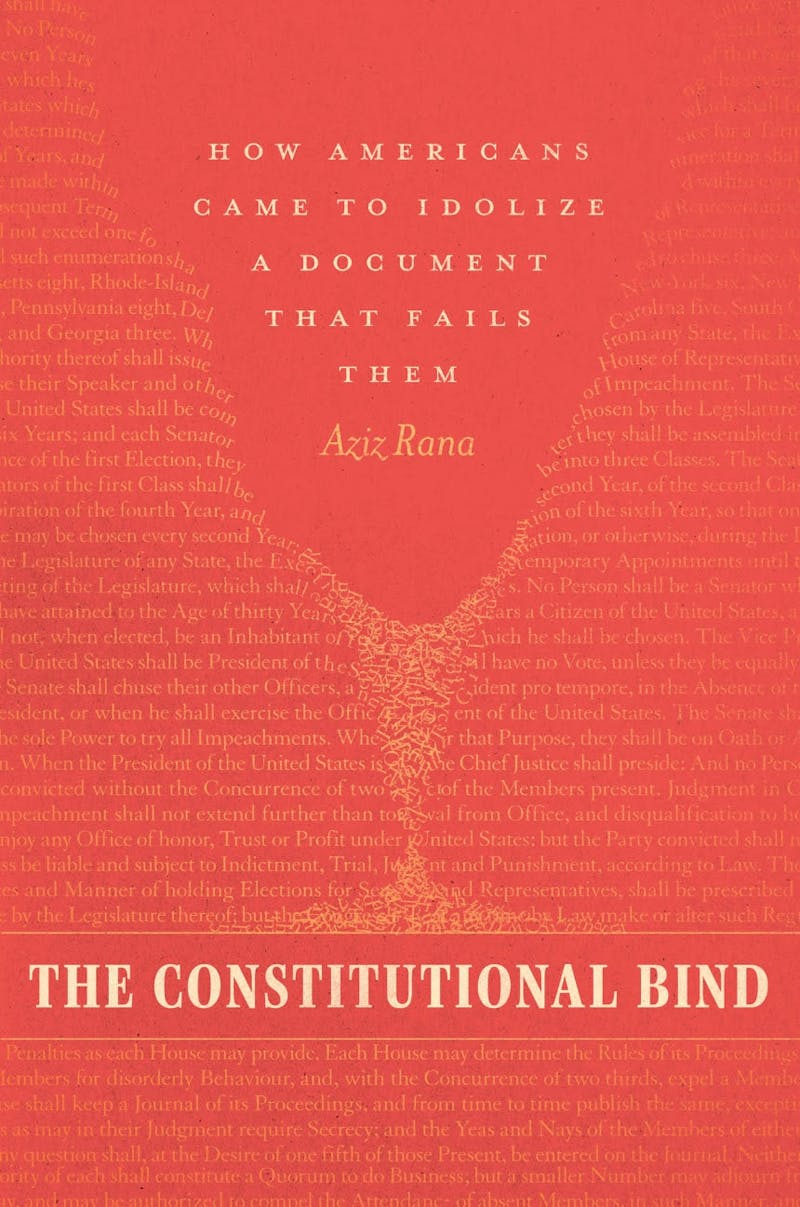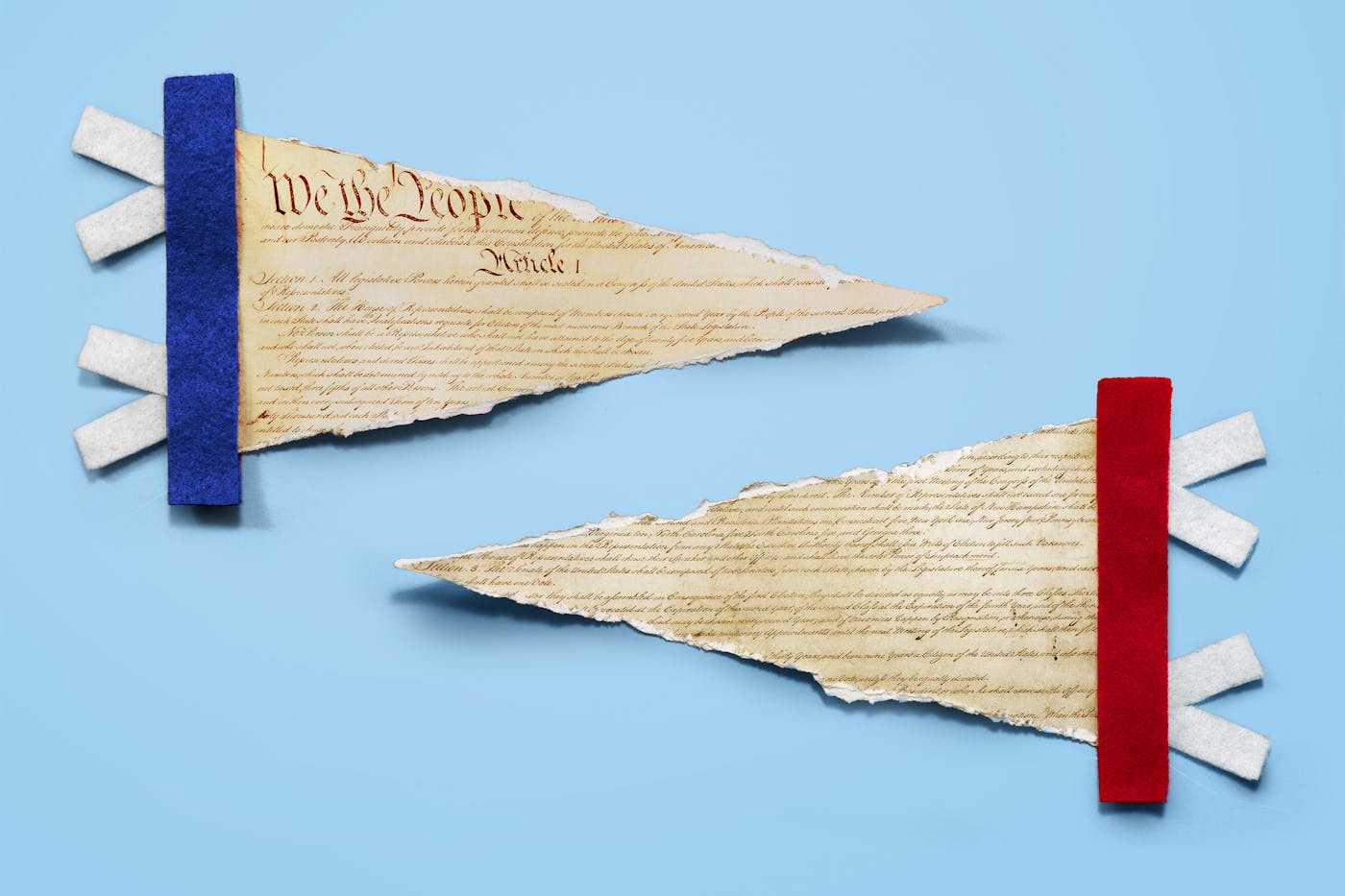Which version of the Constitution will shape America’s future? Emboldened coalitions on the right purport to tether the country’s tomorrows to the original meanings of an eighteenth-century Constitution—or to so-called natural law principles that are even older. Anxious liberals, by contrast, hold out frayed hopes that a living Constitution will be able to translate the nation’s constitutional history into a new century. An increasingly vocal cadre on the left proposes something altogether different—to scrap the whole arrangement, to make a clean break from a tarnished constitutional tradition by marginalizing the Supreme Court and doing away with the project of the Constitution entirely.
In his new book, The Constitutional Bind, lawyer and political theorist Aziz Rana adds his voice to this swelling chorus, urging that a truly emancipatory politics requires breaking free from the U.S. constitutional project. Rana takes aim at what he calls the worship of the Constitution. U.S. politics today, he contends, idealizes the Constitution to its own detriment. Our political formations—especially those on the left—trim their sails in advance of doing battle by accepting the charter’s historical compromises. But such compromises, Rana says, come at a galling democratic cost. They grant unelected justices on the Supreme Court unwarranted authority over the basic terms of our social life. And they sustain voting inequities in the Electoral College and the Senate, which confer unwarranted representation on rural states with disproportionately white and conservative populations.

As late as the first decades of the twentieth century, Rana proposes, Americans took part in a more robust debate over the Constitution, one that nurtured a wild profusion of alternative political visions. The most promising of those visions, in Rana’s eyes, chafed at and often even rejected the Constitution as a parochial and limiting framework. In the middle third of the twentieth century, however, U.S. politics marginalized the political formations that were most critical of the Constitution’s basic terms. And since the middle of the twentieth century, Rana argues, constitutional politics has shape-shifted into a kind of idolatry. Constitutional devotion has sustained American global empire, supported white ethno-nationalism, justified security panics, and cabined real democracy. Constitutional fetishism, according to Rana, sustains “a fundamentally undemocratic order” by granting the Constitution undue “immunity from challenge”; it produces an anti-democratic “cultural genuflection” before a Supreme Court that supports the interests of elites over the liberation of the masses. We are, Rana tells us, bound “by a narrow constitutional narrative” that constrains our collective life and imposes severe limits on our aspirations for true freedom and equality.
Rana’s account is charismatic and forceful on every page. His book conveys the moral weight of arguments against an order that murdered Indigenous peoples, sustained the enslavement of millions of people of African descent, enshrined patriarchy in law, and adopted racial exclusions that made immigrants from Asia ineligible for citizenship. Rana urges us to free ourselves of the charter that sponsored such evils and to chart a new course toward an emancipatory politics, untethered from the crimes of its history. Yet at the heart of the book lies a conundrum. Is there a viable alternative focal point for American democratic politics? Or are shrewd, disillusioned strategists of political change well advised to draw on an imperfect document to make the world a better place?
Rana would have us see veneration of the Constitution as a relatively recent phenomenon. Fighting over the Constitution, he observes, is almost as old as the document itself. In 1788, the charter’s anti-federalist critics literally burned the document in the streets. Fifty-five years later, in 1843, the abolitionist William Lloyd Garrison condemned it as a covenant with death for its compromises on slavery.
The Constitution had its ardent defenders from the beginning, but the basis for today’s Constitution worship began to emerge in the 1850s and 1860s. As scholars like Garry Wills and the late Robert Ferguson showed, Abraham Lincoln and a generation of anti-slavery constitutionalists argued that liberty and equality were woven into America’s constitutional compact. Lincoln’s 1863 Gettysburg address conjured a constitutional order committed to the values enshrined 87 years before in the Declaration of Independence—a “nation, conceived in liberty, and dedicated to the proposition that all men are created equal.” After Lincoln’s assassination, the Thirteenth, Fourteenth, and Fifteenth Amendments wrote these values into the charter’s basic law.
Historians have long observed that in practice the post–Civil War Constitution failed to live up to the anti-slavery ideals of freedom and equality. Rana’s further point is that the document remained hotly contested even in theory. Radical political movements from the late nineteenth century into the twentieth often derided the Constitution as an anti-democratic obstacle to liberation. The Socialist Party of America, for example, conceived of the Constitution and the courts as cogs in the state’s exploitative capitalist machinery; the party’s candidate for president in 1916, Allan L. Benson, condemned a document “by the rich for the rich” in his book Our Dishonest Constitution. Critics of American militarism like ACLU co-founder, feminist, and socialist Crystal Eastman emphasized that peace was essential to human flourishing, to be secured through a system of international cooperation rather than through any one state’s laws. Revolutionary unions like the Industrial Workers of the World, or IWW, fought to seize ownership of the means of production; the Constitution’s protections for the bosses’ property rights, they contended, were a form of legalized robbery from the exploited workers.
In their efforts to maintain independent sovereign nations, Indigenous peoples have been especially fierce critics of the Constitution’s imperial ambitions. Indeed, in Rana’s account, it is Indigenous peoples who, perhaps best of all, have been able to grasp the Constitution’s true structure. Tuscarora Chief Clinton Rickard, for example, resisted the extension of U.S. citizenship—and thus the extension of the Constitution’s reach—as what Rana calls a “negation of Indigenous self-determination.” Rickard insisted, “citizenship was in our own nations.”
Perhaps most spectacularly, American Communists for a time offered a similar self-determination critique of the Constitution, proposing nothing less than to break off part of the United States. Following the party line from the Sixth Congress of the Third International in Moscow in 1928, Communists described a crescent-shaped swath of the South, from Virginia south and west as far as Arkansas, as a nation of African peoples colonized by white capitalists. Self-determination for the so-called Black Belt became a watchword for the party faithful—although support among Southern Black people for national self-determination was modest. Rana’s point is that ferment in the first decades of the twentieth century made available a form of dissent from the framers’ charter that was so radical as to contemplate undoing the Union.
Modern attitudes toward the Constitution began to take shape, Rana contends, in the early twentieth century. World War I brought an era of compulsory patriotism, when President Woodrow Wilson vigorously repressed the world of radical constitutional critique: Wilson’s Department of Justice indicted over 2,000 Americans on Espionage Act charges, convicting more than 1,000 of them, including Socialist presidential candidate Eugene Victor Debs and virtually the entire leadership of the IWW. Many of the Constitution’s most vociferous critics fled the country, were deported, or found themselves in prison.
World War II served to entrench the view of the Constitution as a legitimator of U.S. power, Rana writes. The Supreme Court’s famous 1937 decision to uphold Franklin Roosevelt’s New Deal suggested that a charter mostly written in the eighteenth and nineteenth centuries could adapt to modern social problems. In the years that followed, the New Deal court began to require that states respect individual rights like the First Amendment’s religious freedoms and the Fourth Amendment’s freedom from unreasonable search and seizure—rights that until that point only the federal government had to assure. A new generation of free speech decisions at the court lavished attention on liberty in wartime, overturning flag salute mandates and reversing the denaturalization of Communists. This expansion of freedoms at home, contrasted with totalitarian threats abroad, seemed to instill an entire generation with respect for the Constitution as a document for all ages, tough, resilient, and versatile.
Cold War geopolitical imperatives turned respect into outright adoration. As the legal scholar and historian Mary Dudziak showed in her book Cold War Civil Rights in 2000, decisions like Brown v. Board of Education arose in part out of America’s efforts to style itself as the leader of the free world. Whereas their predecessors had participated in the construction of American apartheid, the justices now proceeded to denounce Jim Crow as unconstitutional. The court also recognized new constitutional rights to privacy in the use of birth control (Griswold v. Connecticut in 1965) and in the right to have an abortion (Roe v. Wade in 1973). Criminal procedure decisions like Mapp v. Ohio (1961) and Miranda v. Arizona (1966) created rights against the police. Cases such as Monroe v. Pape (1961) and Bivens v. United States (1971) recognized new rights to sue government officials for constitutional violations. Free speech decisions like Yates v. United States (1957) and Brandenburg v. Ohio (1969) narrowed the government’s power to prosecute radicals.
All in all, a generation of postwar decisions made the Supreme Court and the Constitution appealing sites for liberal political mobilization. As Chief Justice Earl Warren put it early in his term, the Cold War put the entire U.S. system on trial. The court and the Constitution seemed to rise to the challenge. As Rana writes, lawyers and law professors by the 1970s “did more than simply treat decisions like Brown v. Board of Education as morally well-meaning. They elevated various Warren court cases, with Brown as the centerpiece, to the status of exalted texts.”
At The New York Times Magazine, journalist Anthony Lewis wrote in 1962 that the court had become the “conscience to the country.” Lewis’s bestselling book on the court’s establishment of a right to a lawyer in criminal cases, Gideon’s Trumpet, cast the court as a mighty instrument of justice. (The book became a television movie starring Henry Fonda.) At Yale Law School, dean Eugene V. Rostow praised the court for convening a “vital national seminar” on the country’s most sacred values. For the great liberal institutions of the age, the Warren court infused the Constitution and its authoritative robed interpreters, as Rana puts it, with a kind of “hallowed status.”
In Rana’s telling, the New Deal and the Warren court offered apparent successes but ultimately served to truncate the political imagination. The gains afforded by such cases, considerable though they may have been, fostered fidelity to a Constitution that closed down more radical opportunities. Whereas pre–New Deal social mobilizations critiqued the constitutional order, later movements made crucial compromises with it.
Midcentury labor leaders like Walter Reuther and Sidney Hillman aimed not to replace the constitutional order, but instead to gain for labor some of the wealth afforded by the order that existed. In the Treaty of Detroit, the UAW’s agreement with General Motors set the pattern for future union contracts: Labor would gain strong middle-class wages, job security, and health and retirement benefits, in exchange for dropping its more radical demands. Gone from labor’s lexicon were bolder aspirations such as joint ownership of the means of production or a robust social safety net enshrined in federal law. Rana asserts that such compromises entailed a grave mistake, cutting labor off from more fundamental goals like achieving a true industrial democracy.

The NAACP’s legal campaign to desegregate schools, in Rana’s account, made a parallel mistake. Beginning in the 1910s, the organization had helped to establish constitutional rights for Black criminal defendants, to ban race-based residential zoning, and to contest whites-only primary elections in the South. Yet, Rana argues, the organization’s strategy of working through the courts limited what the NAACP could set out to achieve. NAACP lawyers could win anti-discrimination victories, but they could not launch more foundational attacks on race-based injustice. In cases like Brown v. Board, he asserts, the Warren court gave Black people in the United States court-enforced rules against bigotry without building a foundation for genuine political and economic power.
Rana champions instead radical alternatives like Black nationalists’ 1960s resurrection of the old self-determination idea—“not just US civil rights, but decolonization,” Rana writes. For groups like the Black Panthers, anti-discrimination concessions from the Supreme Court would not suffice. Panther leader Eldridge Cleaver called for revolution on the decolonization model, condemning the electoral system of the United States as fundamentally illegitimate. Malcolm X disciples proposed a Republic of New Afrika that would use a United Nations–backed plebiscite and a new constitution—the Code of Umoja, or Code of Unity—to establish a Black territorial nation state in the Deep South. White radicals at Students for a Democratic Society praised such efforts. The “Black Panther Party,” announced SDS in 1969, “is not fighting black people’s struggles only, but is in fact the vanguard in our common struggles against capitalism and imperialism.” Brown v. Board, by comparison, offered a kind of milquetoast politics of accommodation and reform.
Rana’s account both understates the advantages of working with the Constitution and substantially overstates the popularity and prominence of radical groups that have proposed dispensing with it.
In Rana’s telling, organizers and advocates who tilted against the Constitution gave voice to the views of repressed democratic majorities. Yet none of the groups he highlights enjoyed anything like mass appeal, let alone democratic success. The Socialist Party, Rana tells us, was “electorally viable” in the 1910s. But its high-water mark as a share of the popular vote was 6 percent of the presidential vote in 1912. Membership in the IWW in the first half of the 1910s was tiny, ranging from 10,000 to no more than 30,000 people. (In the same years, the more conservative American Federation of Labor boasted two and a half million members.) Two decades later, the Communist Party’s Black Belt self-determination thesis had almost no support among Black people. The policy was imposed on the Communist Party of the United States of America over the objection of its small cohort of Black members; one Black member in Moscow in 1928 said that there were only about 50 Black members in the entire United States. Forty years later, Martin Luther King Jr. warned that the kind of revolution advocated by the Panthers found “no sympathy and support from the white population and very little from the majority of the Negroes themselves.”
Constitutional veneration has flourished for far longer than Rana allows. In 1887, on the occasion of the centennial celebration of the Constitution’s framing, the editors of The New York Times wrote of “AN INSPIRED CONSTITUTION,” praising it both for offering equal opportunity to the immigrant masses and for repressing the anarchists of Haymarket. In 1909, The New Republic’s future co-founder Herbert Croly gushed in The Promise of American Life that “Americans have more reason to be proud” of the Constitution’s “triumph than of any other event in their national history.” Croly’s view, which was wholly unexceptional for the time, was that the “formation of an effective nation out of the thirteen original colonies was a political achievement for which there was no historical precedent.”
Constitutional critique as a political strategy was typically weak, in part because social movements have tended to find that invoking patriotism and the Constitution brings significant payoffs in U.S. politics. The early American Civil Liberties Union, as Laura Weinrib has shown, invoked the Constitution’s free speech clause to advance a radical labor syndicalism. (“Get a lot of good flags” and “talk a good deal about the Constitution,” urged ACLU co-founder Roger Baldwin.) The Highlander Folk School, where organizers like Myles Horton, Rosa Parks, and Martin Luther King Jr. connected Southern agricultural workers to Appalachian socialism and Black emancipation, took Baldwin’s advice to heart. Highlander flew U.S. flags prominently and proudly. So did the Congress of Industrial Organizations. For these groups and many more in the early-twentieth-century left, social mobilization aimed to co-opt and remake the national tradition by elevating its virtues, not to reject it for its ugly vices. In this they followed the efforts of the pre–Civil War anti-slavery constitutionalists. Constitutional veneration is not a new phenomenon, not one conjured in the mid–twentieth century, but a recurring cyclical phenomenon, deployed as a tool by rivals vying for political power.
Rana has a tendency to undervalue the gains that canny strategists on the left have made this way. Mass democratic organizations like the CIO—having been set in motion earlier in the century by many of the radicals Rana’s book admires most—built the midcentury prosperity of the American working class. The NAACP’s racial equality project originated in the same circles that produced the CIO and aimed in its earliest formulations to build an organizable Black working class. When its litigation campaign culminated in Brown v. Board of Education, wealth inequality was nearing its historic low point; union density in the private sector was reaching its high point; and Black households became more likely than white ones to have a member belonging to a labor union. Such moments are evidence that the hard work of leftist visionaries brought astonishing transformations.
For Rana, the existing order hobbles the left while empowering the right. The Constitution, with its anti-democratic features, “fundamentally empowers rule by a minority coalition,” he writes, and makes it “especially difficult for today’s multiracial and largely urban majority coalition to implement widely backed policies.” Recent decisions to overturn reproductive rights and insulate unpopular gun rights from majoritarian politics lend Rana’s position added force. U.S. politics is being reshaped by justices whose power has little democratic basis. Five were nominated by presidents who first reached the White House without winning a popular vote majority. At least four purport to deploy an anti-democratic methodology of original meaning rooted in the values of an older, whiter, patriarchal country. All nine were confirmed by a Senate skewed toward low-population states, the same Senate that blocked popular-vote-winning President Barack Obama from filling an empty seat at the court in 2016.
In the past few years, the court has deployed controversial readings of the Constitution to hobble environmental regulations in the fights against climate change and water pollution, to constrain public health measures during the pandemic, to ban race-based affirmative action, and to undo student debt relief. As I write this, the justices seem poised to dramatically reduce the power of government agencies by stripping them of the power to interpret ambiguous laws in the public interest. The court this term is expected, moreover, to rule that the Constitution curbs federal regulatory power over corporate securities markets.
Yet is abandoning the Constitution the correct response? For conservatives, constitutional veneration has served not as a constraint on the political imagination but as a mobilizing tool. As legal scholars like Jamal Greene, Reva Siegel, and Mary Ziegler have shown, originalism has dominated not because it’s a powerful interpretative method (it’s not) but because of its adoption by an effective and energized political coalition. Ostensible original meanings have turned out to be so capacious and flexible as to permit the construction of a successful political movement under the Constitution’s big tent.
Historically, liberals and the left have deployed the Constitution to build coalitions and make change happen, too, and for good reason. Abandoning America’s national charter to one’s political adversaries has been a recurring temptation, and sometimes a stirring call to justice, but never a winning political strategy. The document establishes the boundaries of the body politic and, for better or worse, shapes its identity, too. No wonder Rana’s history offers a litany of losing efforts to change the world for the better.
As for today, there is little evidence that a suppressed left-wing popular coalition of nonwhite and working-class voters lies in wait, chafing to be unleashed from the Constitution’s constraints. Opinion polls find that Latino voters currently favor former President Donald Trump over Joe Biden. Voters who identify as Asian American are widely seen as turning rightward because of issues like crime and education. By some estimates, 40 percent of nonwhite voters will vote for the conservative Republican presidential candidate in 2024. National surveys regularly find essentially half of all voting-eligible people in the country supporting conservative presidential candidates. We live in a nation of razor-thin electoral margins, even absent the distorting influence of the Senate and the Electoral College.
Under such circumstances, a clean break with the Constitution would be as likely to produce a turn to the right as to the left. Rana acknowledges as much in the book’s surprising final pages: Breaking from the thrust of his historical account, he cautions that right-wing critics have been eager for a new constitutional convention in recent years. Rana therefore counsels against counterproductive anti-Constitution radicalisms, urging instead the formation of a practical coalition for the enactment of social democratic policies, at least for now.
But the case for coalition-building is a more general one. Working within the Constitution has not meant giving in to its worst features. The most successful political projects have reshaped the charter time and again. Changing electoral demographics pose new challenges to the task of adapting the document to our times. But making the best of the Constitution’s content has proved politically indispensable for nearly two and a half centuries. The foreseeable political future belongs to the coalition that wins the struggle for its meaning.




